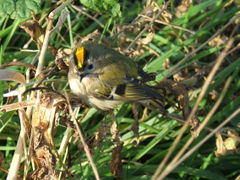Goldcrest
2008/9 Schools Wikipedia Selection. Related subjects: Birds
| Goldcrest | ||||||||||||||
|---|---|---|---|---|---|---|---|---|---|---|---|---|---|---|
 |
||||||||||||||
| Conservation status | ||||||||||||||
|
Least Concern
|
||||||||||||||
| Scientific classification | ||||||||||||||
|
||||||||||||||
| Binomial name | ||||||||||||||
| Regulus regulus (Linnaeus, 1758) |
The Goldcrest, Regulus regulus, is a very small passerine bird in the kinglet family, resembling the Firecrest but with a plainer face. It breeds in most of temperate Europe and Asia but is partly migratory and northern birds winter south of the breeding range. It prefers coniferous woodlands, although it has a wider range in winter, when it is often found with tit flocks. It builds an open nest and lays 4-12 eggs.
The Goldcrest is the smallest European bird, measuring from 8.5 to 9.5cm and weighing as little as 5g. It is dull greenish above, with buffy white underparts, two white wingbars, and a plain face with a conspicuous black eye. The crown has black sides and a narrow black front, and a bright central crest, orange in the male and yellow in the female, which is displayed during breeding. It is a restless species, constantly on the move as it searches for insects.
Goldcrests on the Canary Islands have a broader black band across the forehead, and yellower wingbars. They belong to separate subspecies. They are sometimes considered a separate species, but usually are included in the Goldcrest. Recently, it has been established that there are in fact two distant Canary Islands populations: the Tenerife Goldcrest (R. (r.) teneriffae) and the Western Canary Islands Goldcrest (R. (r.) ellenthalerae) (Päckert et al., 2006).
The Goldcrest is the national bird of Luxembourg. In Britain, Goldcrests were previously called Gold-crested Wrens, and are celebrated in a poem by Charles Tennyson Turner with that title.